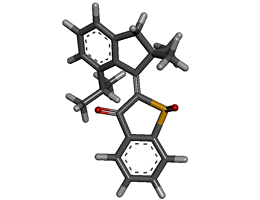Sep 20 2017
Smart nanomachines are experiencing a futuristic growth. LMU Chemists have now altered the synthesis of a molecular motor in order to decrease the speed of its light-driven rotation, thus allowing the Researchers to thoroughly analyze the mechanism of motion.
 Credit: LMU
Credit: LMU
LMU Chemists headed by Dr. Henry Dube have come up with a new method for synthesizing a new generation of molecular motors. Using this method, “we were able to reduce the speed of our molecular motor sufficiently to allow us following its light-driven rotational motion in complete detail,” states Dube, who heads an Emmy Noether Junior Research Group in the Department of Chemistry at LMU. The new study has been published in the journal Angewandte Chemie.
The new compound, similar to its predecessor motor molecule, which was described by Dube and his colleagues in a paper published in Nature Communications in 2015, comprises of a carbon-carbon double bond (C=C). Part of the molecule rotates unidirectionally about this double bond when exposed to light. Additionally, when compared to most other synthetic motor molecules, which are powered by UV light, Dube’s structure is capable of being set in motion by visible light – which is less energetic than UV.
Dube and his team slowed down the rate of rotation by developing a new synthesis that has the potential to yield the desired structure in five steps. The new approach allows for the integration of bulky substituent groups into the final structure, which limit the path open to the rotor, efficiently decreasing its mobility and thus causing a lower overall rotation rate. These alternations enabled the Researchers to observe all four of the predicted intermediates that must be serially traversed in each rotation cycle, and allowed them to establish that the motor’s mode of rotation is certainly unidirectional.
Henry Dube’s research aim at developing the chemical components essential for the construction of nanomachines, which are referred to as molecular assemblies whose structural states and motions can be controlled by external stimuli. When a greater degree of control is achieved, an extensive range of applications become available. The potential to decrease the rate of rotation of the hemithioindigo motor presently makes room for promising applications in catalysis or in the development of smart materials, which can be manipulated in a targeted fashion.